Lian Guo GRAD SCHOOL DIARIES
fish study abroad collaboration student life
A Fishtastic Journey Abroad
Amid a crazy and long field season this year, I partook in the experience of a lifetime – a free trip to Bergen, Norway for a course on Fish Physiology and Sustainable Aquaculture. For two weeks, we attended lectures, learned laboratory techniques, and completed a research project with students and professors from universities in North America, Japan, and Norway. [Aquaculture: farming of aquatic organisms.]
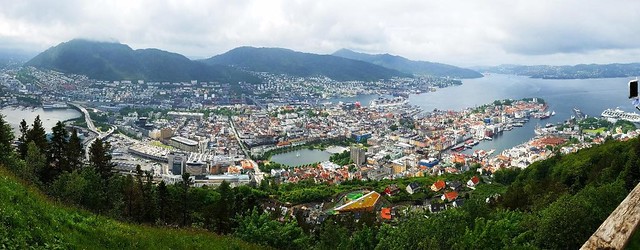
Figure 1. Bergen from above – the view from Mt. Fløyen. Photo by Lian Guo
Now, why would Bergen be a good place to go if your research is related to aquaculture, and particularly sustainable aquaculture? Bergen has a long, rich history as an international trade center of fish goods, beginning in the 14th century. Much of the fishery was based on cod, which were beheaded, dried, and sold in barrels. When cod were eventually overfished, Norway made the shift to aquaculture of Atlantic salmon, halibut, and herring. There is still a vibrant fish market in the center of town, where you can get plenty of caviar, salmon, monkfish, and even have a taste of whale.
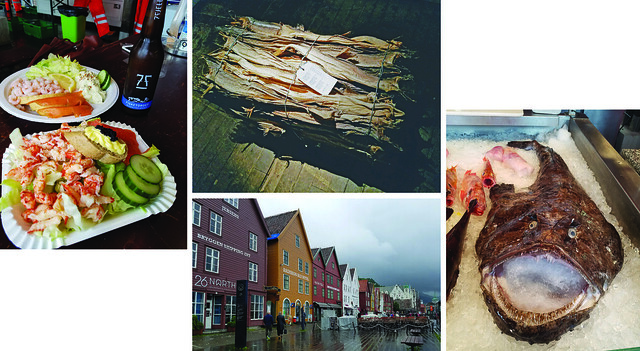
Figure 2. Left – seafood platters and Norwegian pilsner from the Bergen Fish Market. Top center – a barrel of dried cod, as it would have been shipped in the cod heyday. Bottom center – the iconic row of merchant houses known as Bryggen. Right – a ferocious monkfish, also known as anglerfish, on display at the market. Photos by Lian Guo.
Aquaculture and oil are Norway’s two largest exports, meaning it is important for the country to ensure aquaculture will perpetually contribute to the Norwegian GDP. Especially as large scale fish farm projects pop up all over Norway (see below), how can the government ensure that Norwegian waters will always be suitable for aquaculture? In Bergen, there is a hub of academics and private aquaculture companies that have formed numerous collaborations to support a variety of aquaculture research. Everything is studied, from fish nutrition, physiology, genetics, pest control (e.g. sea lice), and large-scale systems for containment of fish.

Figure 3. Large aquaculture sea pens can be found all along the Norway coast (left) and inside fjords (right). Photos by Lian Guo.
Figure 4. A closer look at an Atlantic salmon sea pen. You can see how many fish are cutting through the surface of the water! Video by Lian Guo.
Because of this history, the University of Bergen was an ideal host for our Fish Physiology and Sustainable Aquaculture course. Our lecture classroom was on the water – some of our classmates would even go fishing during our breaks! We learned about fish growth, appetite, digestion, osmoregulation, thermal tolerance, and sensory organs from world-renowned researchers. We also spoke directly with representatives from industry who described research needs and shared ideas about current and future aquaculture.

Figure 5. The view just outside our classroom. Photo by Lian Guo.
We got our hands dirty by working in the lab to learn modern methodology to measure gene expression and proteins. This meant long days working to process samples in order to have presentation-worthy data at the end of the course. One group of students explored the effects of temperature on appetite and digestion, while the other examined how temperature and salinity interact to affect gene expression in gills.
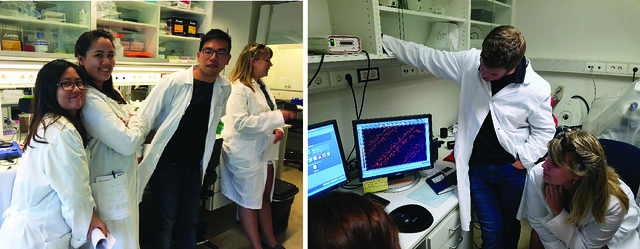
Figure 6. Left - Norwegian, Canadian, and USA graduate students working together in the same lab. Right – My labmates Ciaran and Jessica get a first look at our gill samples that, with fluorescence, show where target proteins are in the tissue. Photos by Lian Guo.
While it was a very busy trip, there was some waiting time in lab and down time after class. We took the opportunity to learn more about the other graduate students (pictured below) and faculty/staff involved in the program. One of my favorite parts of the program were the people. Everyone was friendly, intelligent, and wonderful to be around. In my previous schooling, very little course work was focused exclusively on fish. This experience was a fish-nerd festival for the ages, and I had so many to share it with!
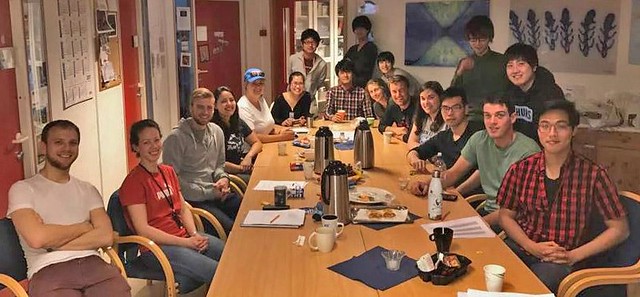
Figure 7. The international group of graduate students attending the Fish Physiology and Sustainable Aquaculture course. Photo taken by Ivar Rønnestad.
The other lasting impression was the universal recognition that sustainable aquaculture is important to research and implement. I heard this repeatedly from academics, industry, and local citizens. It seemed that compared to other countries, the Norwegian aquaculture industry and government felt a high level of responsibility to avoid environmental destruction in aquaculture practice. Similarly, they felt it was logical for there to be institutional financial support for aquaculture-related research to support this endeavor. I felt both envious and disappointed that this is not true for aquaculture practices in North America.
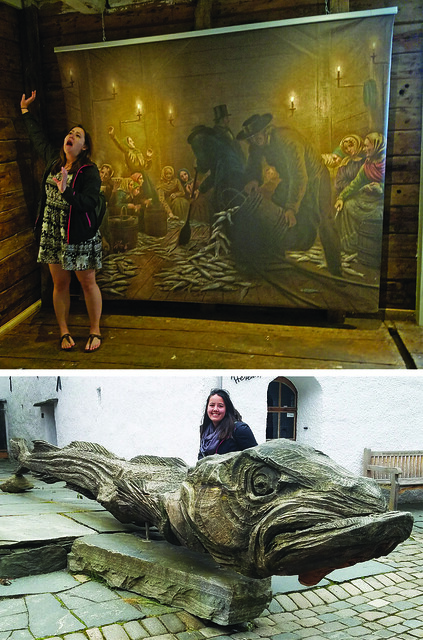
Figure 8. Top - I identified greatly with this piece of art when I found out the women who would package Atlantic herring were called “herring girls.” Since I sometimes have this expression when I work on my own river herring species, so I decided to pose with my long-lost sisters. Bottom – A beautifully carved giant cod, once the primary livelihood for those living in Bergen!
All in all, this was a remarkable learning experience for me. I won’t say I left my heart in Bergen, but I will certainly be keeping my eye out for post-doc positions and jobs there in the future! Where else will I be able to take so many pictures with fish art, and come face to face with lumpfish? Thank you University of Bergen and Norway for such an amazing experience!
Figure 9. The mysterious and enthralling lumpfish, for your viewing pleasure! These fish were being tested as a biological control of sea lice that plague Atlantic salmon sea pens.
